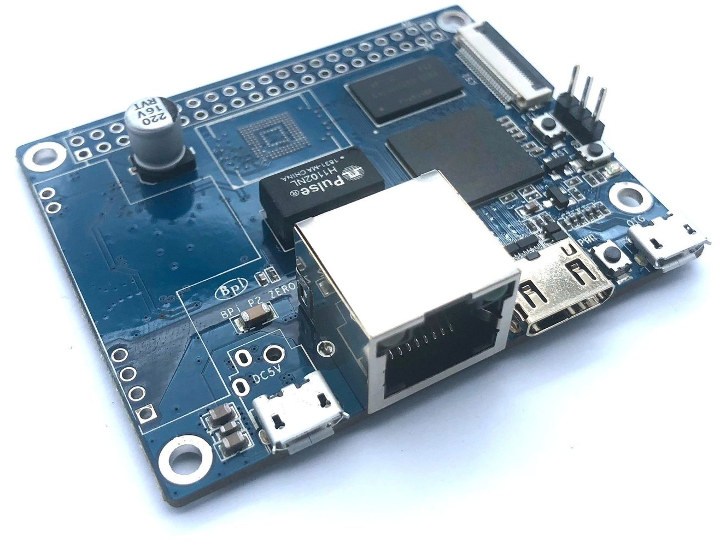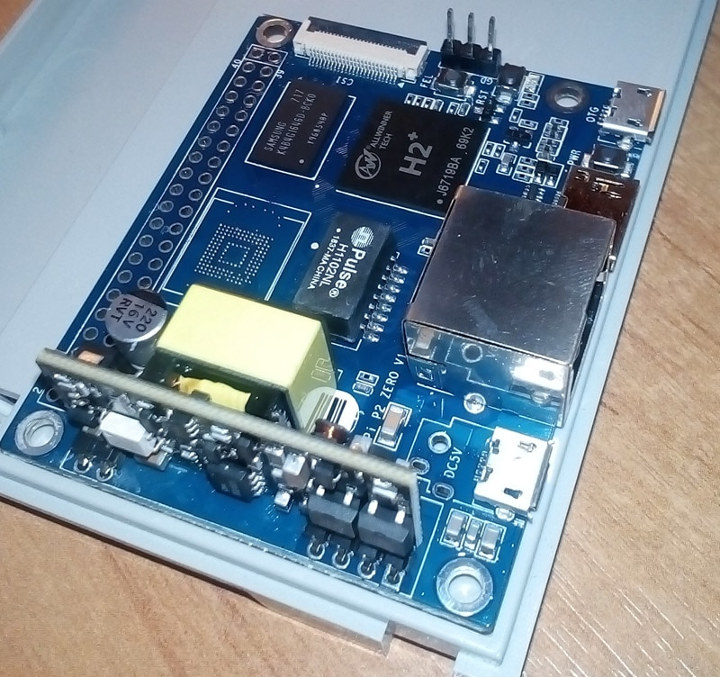Last year SinoVoIP introduced Banana BPI-P2 Zero board powered by Allwinner H2+ processor with 512MB, 10/100M Ethernet with Power-over-Ethernet, WiFi & Bluetooth, a mini HDMI port, and an 8 GB eMMC flash. They also launched a lower cost version without eMMC flash nor wireless module for $16, and the optional PoE module going for $6 extra.
The company is now selling the board at a promotional price of $13 without PoE, and $19 with RT9600 POE module. The shipping fee is not included in those prices however, and in my case, the prices end up at respectively about $25 and $31 with shipping.

Banana Pi BPI-P2 Maker specifications:
- SoC – Allwinner H2+ quad-core Arm Cortex A7 processor with Mali-400MP GPU.
- System Memory – 512MB DDR3 SDRAM.
- Storage – microSD card slot
- Video Output – mini HDMI port
- Connectivity – 10/100M Ethernet with optional PoE support
- Camera I/F – Parallel CSI (Camera Sensor Interface) camera interface, aka DVP (Digital Video Port)
- USB – 1x USB OTG port
- Expansion – 40-pin GPIO header with UART, SPI, I2C, etc…
- Debugging – 3-pin UART header for serial console access
- Misc – Reset and power keys
- Power Supply
- 5V/2A via micro USB port
- Optional Power-over-Ethernet (PoE)
- Dimensions – 65 x 52.5mm

The board is suitable for projects where a single Ethernet cable is desirable for data and power, and the parallel CSI connector makes it ideal for surveillance cameras.
Documentation and software resources can be found in BPI-P2 Zero Wiki. Ubuntu 16.04 and Android 4.4 firmware images are provided for the board. SinoVoIP keeps with the time tested tradition of making IP cameras as insecure as possible, since the images are based on Linux 3.4, which should leave several years of security vulnerabilities allowing potential hackers easier access your device. In all fairness, Linux 4.14 is also being worked on for the Ubuntu 16.04 image, but camera support is still under development according to the features map, so if the information is correct you’d be stuck with Linux 3.14 for projects leveraging the CSI interface.

Jean-Luc started CNX Software in 2010 as a part-time endeavor, before quitting his job as a software engineering manager, and starting to write daily news, and reviews full time later in 2011.
Support CNX Software! Donate via cryptocurrencies, become a Patron on Patreon, or purchase goods on Amazon or Aliexpress





H2+ does not have a MIPI CSI. It has a DVP interface. Allwinner likes to use Camera Sensor Interface contrary to normal convention.
Thanks, I’ve removed the MIPI references in the article.
Somewhat cool board, but Allwinner is on my don’t-ever-buy-there-again list.
What would you buy instead?
This is one of the only forums in the whole wide internet where the majority of readers don’t seem to realize that around 99% of SBC users buy RPi. Community and mainline kernel support + true 64-bit processing are extremely critical requirements for most.
>realize that around 99% of SBC users buy RPi.
What is an SBC user? It’s possible 99% of the people wanting a cheap emulator machine buy a RPI but I doubt it’s close to 99% of the whole SBC market considering how poor the RPI machines have been until now.
>Community
The RPI community is pretty crap really. You only have to look at their forums. Someone asks a technical question, the try hards all come out to totally misunderstand what was being asked, demonstrate they have no idea and then give up and claim it must be impossible. I’ve seen “trusted” members of their community totally misunderstand how very basic stuff like SPI works and totally confuse people asking simple questions by leading them in totally the wrong direction.
> and mainline kernel support
Is it really any better than sunxi? Raspbian isn’t a mainline kernel is it?
>true 64-bit processing are extremely critical requirements for most.
Why would they buy a machine that has a crippled 32bit userland then?
If they require 64-bit processing they won’t be using an RPi as the provided software is still running 32-bit!